Chapter 17.52*
FENCES, WALLS AND HEDGES
Sections:
17.52.010 Fences, walls and hedges in front yards of noncorner lots.
17.52.020 Fences, walls and hedges in side and rear yards of noncorner lots.
17.52.030 Fences, walls and hedges on corner lots.
17.52.040 General regulations.
17.52.050 Nonresidential properties.
17.52.060 Public utilities and infrastructure.
17.52.070 Exception process.
17.52.080 Enforcement.
* Prior history: Ord. 507.
17.52.010 Fences, walls and hedges in front yards of noncorner lots.
A. Fences. In all residential zoning districts, fences may be permitted in the front yard area of noncorner lots if all of the following conditions are met:
1. The fence does not exceed forty inches in height; and
a. The fence is constructed of materials shown in Section 17.52.040.
2. Exception. The fence may increase to six feet in height if:
a. The fence is set back a minimum of twenty feet from the back of sidewalk; and in all instances placed far enough from the street such that the amount of landscaped area visible from the street is generally consistent with other lots located in the same block; and
b. The fence’s location does not obstruct pedestrian or vehicular access to the house and does not block the view of the house from the street; and
c. The fence’s location is not closer to the street than the house’s primary front wall nearest to the street from which the fence is extended; and
d. The fence is constructed of fifty percent open-air materials shown in Section 17.52.040; and
e. The fence’s design, location and orientation shall be subject to review and approval by the community development director; and
f. All items stored or temporarily placed behind the fence shall be lower than the height of the fence.
B. Walls. In all residential zoning districts, walls not exceeding forty inches in height may be permitted in the front yard area of noncorner lots if the following conditions are met:
1. The wall is constructed of materials shown in Section 17.52.040; and
2. All items stored or temporarily placed behind the wall shall be lower than the height of the wall.
C. Hedges. As depicted in Diagram A, in all residential zoning districts, hedges may be permitted in the front yard of noncorner lots if the following conditions are met:
1. The hedge is planted parallel to the street and does not exceed forty inches in height; and
a. The hedge is neatly pruned and maintained in a healthy and vigorous condition.
2. The hedge is planted perpendicular to the street, located within five feet of a driveway, and does not exceed forty inches in height from back of sidewalk for a distance of five feet, at which point it may increase to six feet in height; and
a. The hedge is neatly pruned and maintained in a healthy and vigorous condition.
3. The hedge is planted perpendicular to the street, located more than five feet from the edge of a driveway, and does not exceed six feet in height; and
a. The hedge is neatly pruned and maintained in a healthy and vigorous condition.
DIAGRAM A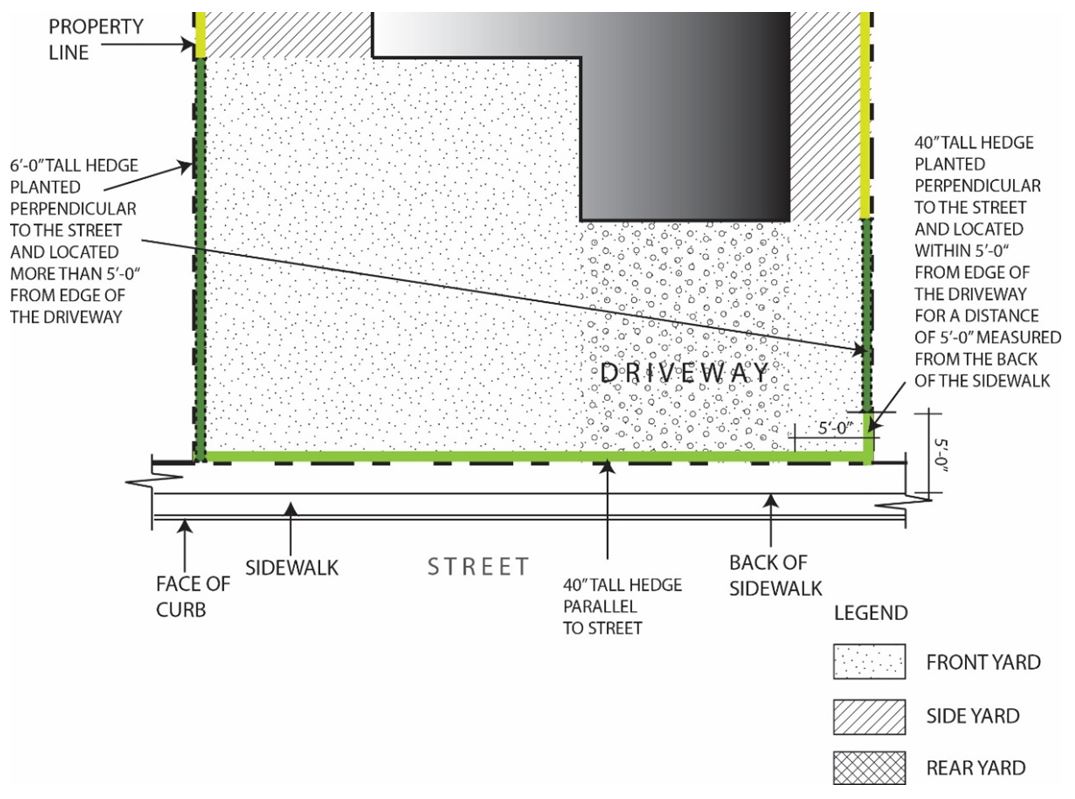
(Ord. 612 § 1 (part), 2017: Ord. 589 § 1 (part), 2014)
17.52.020 Fences, walls and hedges in side and rear yards of noncorner lots.
A. Fences—Nonwaterfront Properties. In all residential zoning districts, fences may be permitted in the side or rear yards of noncorner lots if all of the following conditions are met:
1. The fence does not exceed six feet in height; and
2. The fence is constructed of materials shown in Section 17.52.040; and
3. All items stored or temporarily placed behind the fence shall be lower than the height of the fence.
4. Exception. Wood fences not exceeding seven feet in height may be permitted in any side and rear yard area if all fence material above six feet in height consists of wood lattice with a weave that is approximately fifty percent open.
B. Walls—Nonwaterfront Properties. In all residential zoning districts, walls may be permitted in the side or rear yards of noncorner lots if all of the following conditions are met:
1. The wall does not exceed six feet in height; and
2. The wall is constructed of materials shown in Section 17.52.040; and
3. All items stored or temporarily placed behind the wall shall be lower than the height of the wall.
C. Hedges—Nonwaterfront Properties. In all residential zoning districts, hedges may be permitted in the side or rear yards of noncorner lots if all of the following conditions are met:
1. The hedge does not exceed twelve feet in height; and
2. The hedge is neatly pruned and maintained in a healthy and vigorous condition.
D. Fences and Walls—Waterfront Properties—Side Yards of Noncorner Lots. In all residential zoning districts, fences and walls may be permitted in the side yards of noncorner lots if all of the following conditions are met:
1. The fence or wall does not exceed six feet in height; and
2. The fence or wall is constructed of materials shown in Section 17.52.040; and
3. All items stored or temporarily placed behind the fence or wall shall be lower than the height of the fence or wall.
4. Exception. Wood fences not exceeding seven feet in height may be permitted in any side yard area if all fence material above six feet in height consists of wood lattice with a weave that is approximately fifty percent open.
E. Hedges—Waterfront Properties—Side Yards of Noncorner Lots. In all residential zoning districts, hedges may be permitted in the side yards of noncorner lots if all of the following conditions are met:
1. The hedge does not exceed twelve feet in height; and
2. The hedge is neatly pruned and maintained in a healthy and vigorous condition.
F. Fences, Walls and Hedges—Waterfront Properties—Rear Yards. In order not to significantly interfere with views of the lagoon from adjacent properties, fences, walls and hedges may be permitted in rear yards if all of the following conditions are met:
1. Rear Yards Less Than Twelve Feet in Depth. The fence, wall or hedge does not exceed seventy-two inches in height in the first half of the rear yard measured from the rear wall of the house nearest to the water. The fence, wall or hedge then steps down to a height not to exceed forty-two inches in the second half of the rear yard. (Diagram B)
DIAGRAM B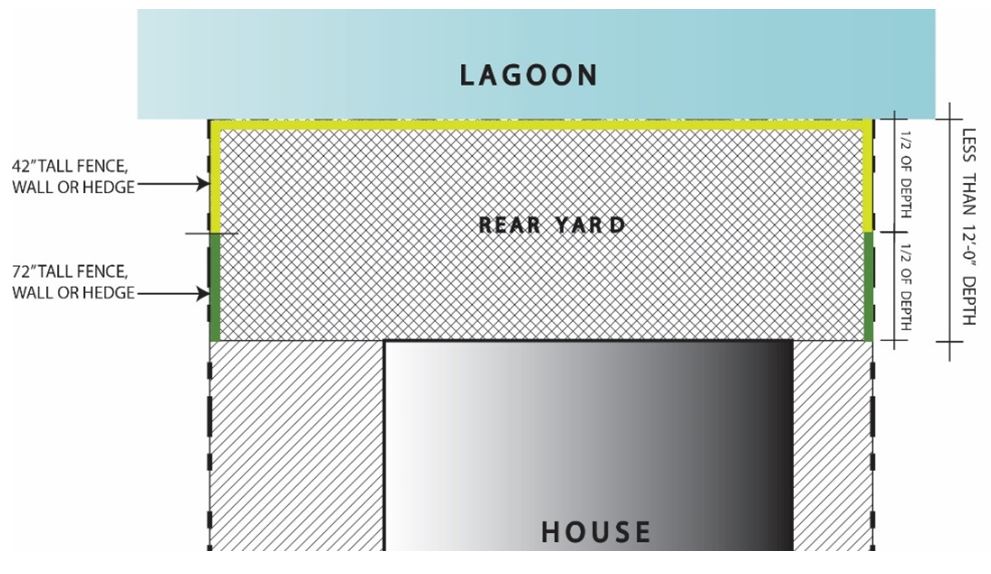
2. Rear Yards Twelve to Thirty-Five Feet in Depth. The fence, wall or hedge does not exceed seventy-two inches in height in the first third of the rear yard measured from the rear wall of the house nearest to the water; fifty-seven inches for the next third of the rear yard; and forty-two inches in the final third of the rear yard. (Diagram C)
DIAGRAM C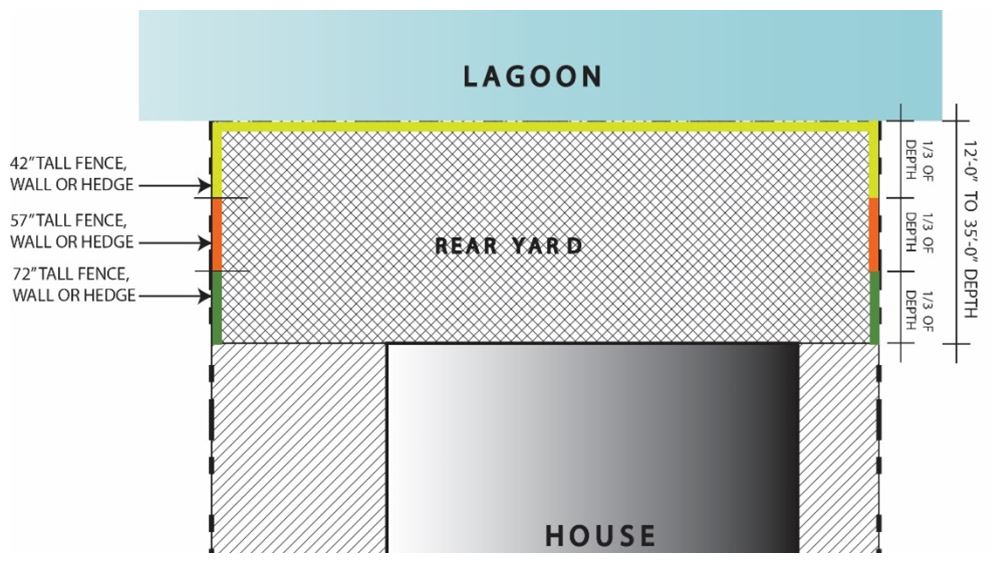
3. Rear Yards Exceeding Thirty-Five Feet in Depth. The fence, wall or hedge does not exceed seventy-two inches in height in the first quarter of the rear yard measured from the rear wall of the house nearest to the water; sixty-two inches in the second quarter of the rear yard; fifty-two inches in the third quarter of the rear yard and forty-two inches in the final quarter of the rear yard. (Diagram D)
DIAGRAM D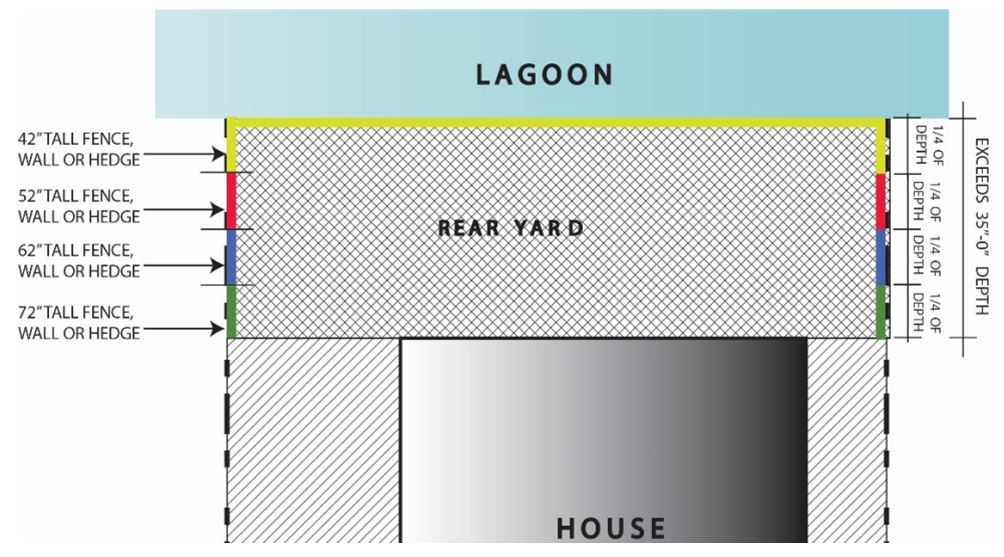
4. The hedge is neatly pruned and maintained in a healthy and vigorous condition. (Ord. 612 § 1 (part), 2017: Ord. 589 § 1 (part), 2014)
17.52.030 Fences, walls and hedges on corner lots.
A. To ensure proper pedestrian and vehicular visibility, at a corner lot intersection which is not controlled by all-way stop signs, no fence, wall or hedge exceeding forty inches in height shall be located within a twenty-five-foot triangle formed at the intersection of the two streets measured at the property line, as outlined in Diagram E below:
DIAGRAM E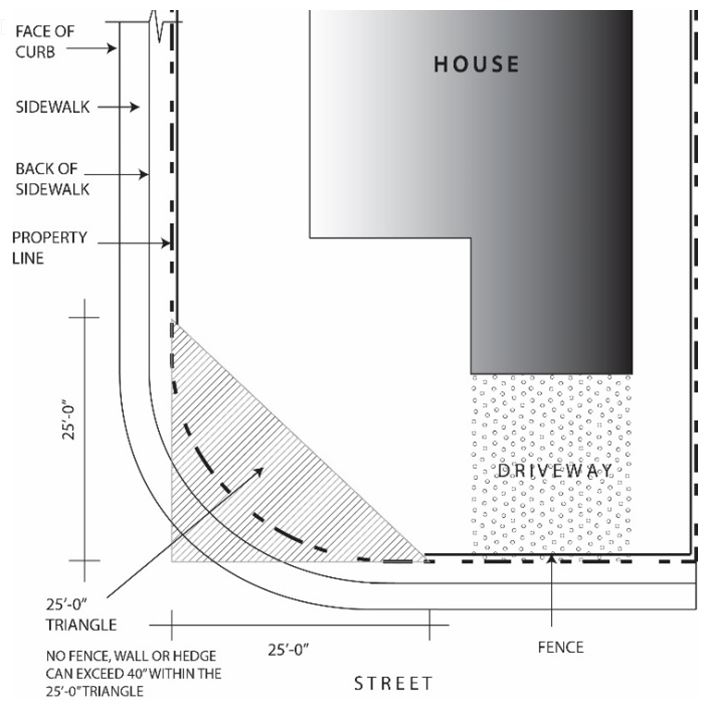
1. The hedge is neatly pruned and maintained in a healthy and vigorous condition.
2. Corner lots controlled by all-way stop signs are not subject to the limitation in this subsection A.
B. In order to ensure pedestrian and vehicular visibility, at a corner lot where the rear yard of such corner lot abuts a property that fronts the side street which is an arterial or collector street as identified in the Foster City general plan, fences, walls and hedges may be permitted if all of the following conditions are met:
1. The fence, wall or hedge does not exceed six feet in height; and
2. The fence, wall or hedge does not extend into the front yard area; and
3. The fence, wall or hedge does not extend within five feet of the side property line along the side street; and
4. The hedge is neatly pruned and maintained in a healthy and vigorous condition.
5. In those instances where a driveway on the adjoining property is located within fifteen feet of the rear property line of the corner lot, such fence, wall or hedge is not permitted within a triangle formed by a ten-foot line along the rear property line and a twenty-foot line along the side property line. (See Diagram F below.)
DIAGRAM F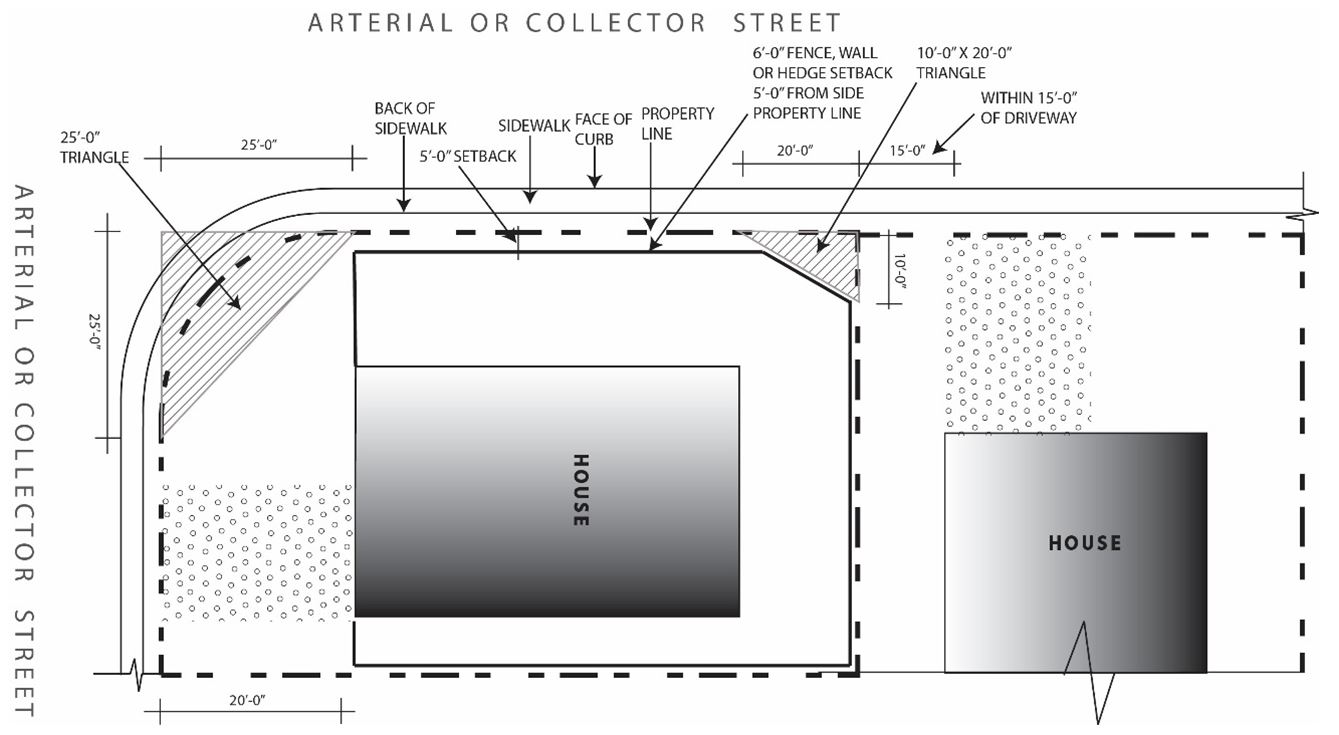
C. In order to ensure pedestrian and vehicular visibility, at a corner lot where the rear yard of such corner lot abuts a property that fronts the side street which is not an arterial or collector street as identified in the Foster City general plan, and where a driveway on the adjoining property is located within fifteen feet of the rear property line of the corner lot, fences, walls and hedges may be permitted if all of the following conditions are met:
1. The fence, wall or hedge does not exceed six feet in height; and
2. The fence, wall or hedge does not extend into any front yard area; and
3. The hedge is neatly pruned and maintained in a healthy and vigorous condition; and
4. The fence, wall or hedge is not located within a triangle formed by a ten-foot line along the rear property line and a twenty-foot line along the side property line. (See Diagram G below.)
DIAGRAM G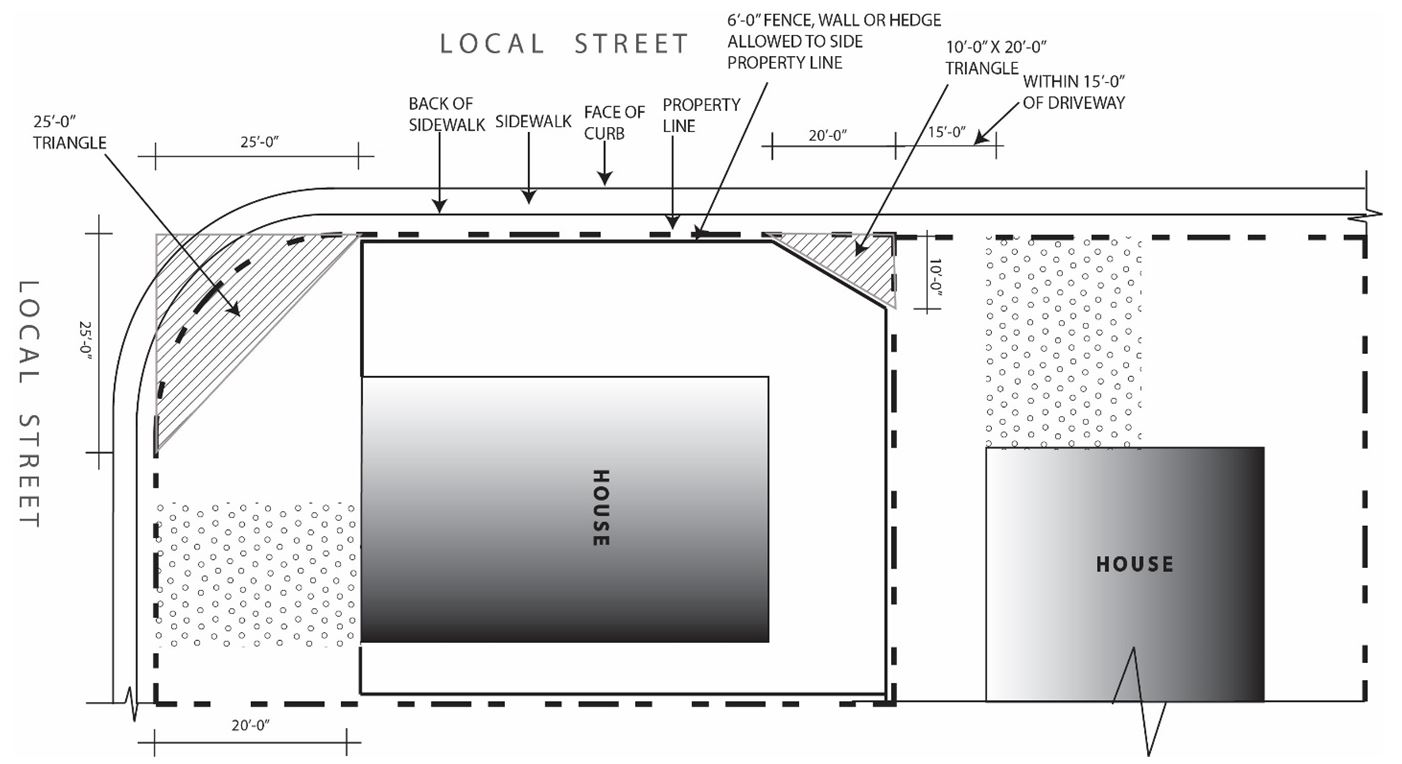
(Ord. 612 § 1 (part), 2017: Ord. 589 § 1 (part), 2014)
17.52.040 General regulations.
In addition to the requirements outlined in Sections 17.52.010 through 17.52.030, fences, walls and hedges located in any district shall also be subject to the following regulations:
A. The height of fences, walls and hedges shall be measured from the side which has the highest finished grade level at the base of the fences, walls and hedges.
B. Unless otherwise required by the Uniform Building Code, only fences exceeding six feet in height, and masonry or concrete walls exceeding three feet in height, will require a building permit.
C. Materials for construction of permanent fences and walls along property lines shall be limited to the following: redwood, cedar, brick, slumpstone, stucco, plaster, cement, wrought iron, or similar materials as determined by the community development director. Additionally, clear tempered glass or clear Plexiglas shall be allowed on rear and side yards of waterfront properties only. Chain-link and wood or synthetic slats (e.g., vinyl slats) may be allowed for commercial, industrial or institutional uses, depending on location and design.
D. Materials for the construction of temporary fences and walls shall be limited to: plywood, chain-link and redwood slat, or other suitable materials as determined by the community development director depending upon site location.
E. Fence and wall colors shall be neutral, not bright, and compatible with the existing residence and neighborhood.
F. Fences and walls shall be designed to be compatible with the existing site and surrounding properties.
G. Front and side yard fence columns, decorative objects, and light fixtures which do not obstruct the line-of-sight for drivers of vehicles may exceed the established front height restriction as follows:
1. By one and one-half feet, including that over a fence gate that is at least five feet six inches in height, an arbor may be attached not to exceed twenty square feet that is one hundred percent open on two sides and at least fifty percent open on two sides, subject to architectural review and being maintained in good repair; or
2. An arbor up to seven feet six inches in height may be constructed over a front yard fence gate or opening not to exceed four feet in width and two feet in depth, not to exceed eight square feet, that is one hundred percent open on two sides and at least seventy-five percent open on two sides, subject to architectural review and being maintained in good repair.
H. For houses located within planned developments, a letter demonstrating written action by the homeowners’ association on the proposal shall be obtained prior to submitting plans to the city. The proposed fence(s) or wall(s) shall be consistent with the prototypical design guidelines for the association (if any) on file with the city. (Ord. 612 § 1 (part), 2017: Ord. 589 § 1 (part), 2014: Ord. 588 § 1, 2014; Ord. 515 § 2 Exh. A (part), 2005; Ord. 449 § 1, 1998; Ord. 448 § 1, 1998; Ord. 427 § 1, 1996; Ord. 421 § 1 Exh. A (part), 1995; Ord. 391 § 1 Exh. A (part), 1992; Ord. 355 § 1, 1989: Ord. 285 § 1, 1984: Ord. 38 § 1 (part), 1972: prior code § 10-406.070. Formerly 17.52.010)
17.52.050 Nonresidential properties.
Architectural review by planning commission per Section 17.58.040(C) is required for fences or wall structures exceeding six feet in height which enclose commercial or industrial uses, tennis courts, semipublic swimming pools, or similar recreation areas, or school play-yard areas. Fences or wall structures over six feet may also be permitted within any building setback line, subject to the review and approvals established in this chapter for such district. (Ord. 612 § 1 (part), 2017: Ord. 589 § 1 (part), 2014)
17.52.060 Public utilities and infrastructure.
A. Fences, walls and hedges shall not obstruct access to public utilities or infrastructure including but not limited to street light poles, fire hydrants, water meters, utility boxes, street signs, stop signs, traffic control signs and sidewalks.
B. Hedges shall be maintained so they do not obstruct the light fixture of a street light pole and shall not grow within four feet of the light fixture.
C. If a property owner refuses to remove fences, walls or hedges which are obstructing access to public utilities and infrastructure, including but not limited to fire hydrants, water meters, utility boxes or street light poles, the city may remove the obstruction in order to gain access. (Ord. 612 § 1 (part), 2017: Ord. 589 § 1 (part), 2014)
17.52.070 Exception process.
A. An exception to the requirements of this chapter may also be granted administratively by the community development director if all of the following findings are required to be made:
1. The exception is necessary to allow the use and enjoyment of the applicant’s property.
2. The proposed fence, wall or hedge configuration/height would be compatible with the design, appearance and scale of existing building and structures in the neighborhood.
3. The proposed fence, wall or hedge will not interfere with pedestrian and vehicular visibility.
B. Appeal Period—Issuance.
1. Exceptions shall not be issued until ten calendar days have elapsed from the granting thereof, to allow time for any appeal to be filed. In case an appeal is filed, the exception shall not be issued until a decision is made on the appeal.
2. Exceptions shall not have any force and effect until the permittee acknowledges receipt thereof and acceptance of any conditions thereto.
C. Appeal Procedures.
1. In case the applicant, or any other person, is not satisfied with any decision of the community development director, they may, within ten calendar days after the decision, appeal in writing to the planning commission, accompanied by a fee as set by resolution of the city council. The appeal letter or completed appeal form shall specify:
a. The person making the appeal;
b. The specific item of appeal, and all supporting documentation, written in clear and concise language;
c. The basis for such appeal; and
d. The relief or action sought.
2. Upon receipt of the complete appeal letter and fee, the city clerk shall transmit one copy of the appeal letter to the applicant. The planning commission shall review the written findings of the community development director on the matter and shall consider the written and oral argument of the appellant. Information not presented to the planning director for consideration prior to rendering a decision may not be introduced at the meeting of the planning commission on the appeal. However, where the appeal was filed by a third party appellant, the appellant shall have the right to present evidence in support of the appeal.
3. Decisions of the Planning Commission.
a. If the applicant or any other person is not satisfied with any decision of the planning commission, they may, within ten calendar days after the decision of the planning commission, appeal in writing to the city council, accompanied by a fee as set by resolution of the city council. The appeal letter or completed appeal form shall contain the same information as required above for appeals of decisions of the planning director.
b. Upon receipt of the complete appeal letter and fee, the city clerk shall schedule the appeal before the city council. The city council shall review the written findings of the planning commission on the matter and shall consider the written and oral argument of the appellant. New matter may not be introduced by either party to such appeal. The decision of the city council shall be final. (Ord. 612 § 1 (part), 2017: Ord. 589 § 1 (part), 2014)
17.52.080 Enforcement.
A. Violation—Infraction. Any person who commits any act declared by any provision of this chapter to be unlawful, or who violates the provisions or fails to comply with the mandatory requirements of any section or portion of this title, shall be guilty of an infraction, punishable by:
1. A fine not exceeding one hundred dollars for a first violation;
2. A fine not exceeding two hundred dollars for a second violation of the same provision within one year;
3. A fine not exceeding five hundred dollars for one additional violation of the same ordinance provision within one year.
For purposes of this section, each day in which a nonconforming condition continues is a single violation and each subsequent day such nonconforming condition continues is a new and separate offense.
B. Violation—Nuisance Declaration—Abatement. In addition to the penalties provided in subsection A of this section, any fences, walls or hedges constructed, planted, or maintained contrary to the provisions of this chapter are public nuisances. The city attorney, upon order of the city council or community development director, may commence the necessary action or proceedings for the abatement, removal and enjoinment thereof in the manner prescribed by law in the courts which may have jurisdiction to grant such relief as will accomplish such abatement and restraint. The remedies provided for in this section shall be in addition to any other remedy or remedies or penalties provided in this chapter or any other law or ordinance.
C. Violation—Penalty Fees. In addition to the penalties provided in subsections A and B of this section, if any fence, wall or hedge is constructed, planted, or maintained contrary to the provisions of this chapter, the city council, by resolution, may establish and assess a penalty fee to eliminate any violation, including violations which only require the securing of a permit but otherwise conform to the regulations of this title. Such penalty fees shall not apply to any application necessary to make a legal nonconforming use conform to the current regulations. (Ord. 612 § 1 (part), 2017: Ord. 589 § 1 (part), 2014)


